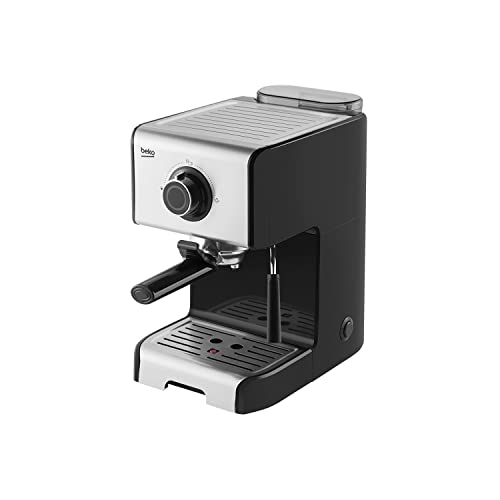Coffee and Espresso Machines
Espresso machines use pressure to push water through finely ground and tamped coffee beans. They make a rich, delicious cup of coffee.
Good Housekeeping Institute experts recommend models that can be brewed with 9 bars minimum for a perfect extraction. Beware of companies that claim to use more pressure than is necessary.
Types
The espresso machine (also called a coffee maker and Espresso maker) makes coffee that is more concentrated and of higher quality, and is more expensive than the typical cafe drinks. It uses an average of nine bars of pressure. These machines have many options, such as temperature and brew-strength control with programmable brewing as well as multiple sizes of drinks. Some machines might have steam wands with either manual or automatic settings for creating texturized milk for Latte art. There are three main types: semi-automatics, super-automatics and automatic. Each one has its own level of control and automation.
The most popular espresso machine type for specialty coffee shops is the semi-automatic model. Semi-automatic espresso machines allow baristas to have full control over the brewing process, but are not as user friendly as fully automated or automated machines. You still need to grind beans, fill and tamp the portafilter, and adjust the extraction duration to ensure the highest espresso shot of the highest quality.

Automated machines come with an integrated mill that can measure and make sure your grounds are tamp. They automatically pour out enough water to extract espresso and often have a programmable beverage size. They were the most commonly used espresso machine model in our lab tests, and they provide a great combination of consistency and human control.
Functions
You'll need a reservoir store the water used to make coffee, irrespective of whether you opt for a steam-driven or pump-driven machine. You'll also have a heating component that is used to heat the water to create the pressure needed to extract the coffee from the grounds.
When the brew lever is raised, it triggers the water inlet cam to seal the valve that prevents pre-infusion so only hot water that is pressurized thoroughly can flow through the portafilter before being ground into coffee. It takes around 25 seconds for the water to make espresso.
The insulated tubing referred to as the hot-water tube extends from the reservoir to the spout on top of your machine. The heating element that resists is responsible for heating the water as the water moves through the aluminum tube and warming plate.
After the spout has turned on then place your cup under the spout, so that the espresso flows into your drink through the portafilter. The coffee maker will come with a steam wand that you can use to heat and froth the milk for beverages that contain espresso like cappuccino or the latte.
Automated machines remove the guesswork of brewing. They operate with a single button, are programmable and can grind and measure beans for you as well as tamp them down. In our Lab tests, they are found to perform the best because they're user-friendly and don't require any special skills from the user.
Materials
The inside of an espresso machine is a jungle of copper tubes, stainless steel boilers, and intelligent firmware. They might appear complicated but at the core they do one simple thing: force hot water through finely-ground coffee.
When buying an espresso machine it is important to consider the size and space requirements as well as drink options, energy saving options, and brewing precision. Look for a button that can be used to activate the steam wand. This is used to create Latte Arts and frothing milk. A gauge of pressure on front of the machine informs you of the operating boiler and pump pressure. Look for a coffee maker with two needles, so that you can both the minimum and maximum pressure.
If you're looking for more then espresso, then you should consider an espresso machine that comes with various brew sizes. This includes ristretto. You can also find models that come with an hopper that can be removed for hands-free, hassle-free frothing and the ability to switch between different kinds of milk. Make sure you choose a model with an inbuilt softener, if you have hard water to avoid mineral accumulation and to keep your espresso fresh.
Some manufacturers use a PID (proportional, integral, digital) thermostat to keep an exact temperature range for espresso brewing. This feature ensures a consistent, high-quality cup of espresso every time. It also reduces cost of energy, as the machine only runs when it's necessary.
Maintenance
As espresso and coffee machines are more widely available for home use, the regular maintenance of the equipment becomes more essential. Having the most efficient equipment can make all the world of difference in your cup of coffee, but it's only true if the machine is working properly.
Regular maintenance and cleaning must consist of everything from cleaning the steam wand, group head and water filter, as well as descaling and changing the water filter regularly. If you're making between two and five coffees every day, it's recommended to clean the machine's main parts every week. However, some components of the machine, such as the grinder and water tank, will need to be cleaned every two to three weeks.
Additionally, you should backflush your machine on a weekly basis. This process involves locking the portafilter in place and running the brew cycle a few times. This can help eliminate any coffee ground or oil that has been left behind. You can also clean the portafilter by using a brush and cleaner that is specifically made for espresso machines.
Maintaining your coffee machine and espresso correctly will also help it last longer. A lot of professional espresso machines found in cafes and offices cost a lot of money, and it is vital to keep your machine in good shape so that it can last as long as possible.
